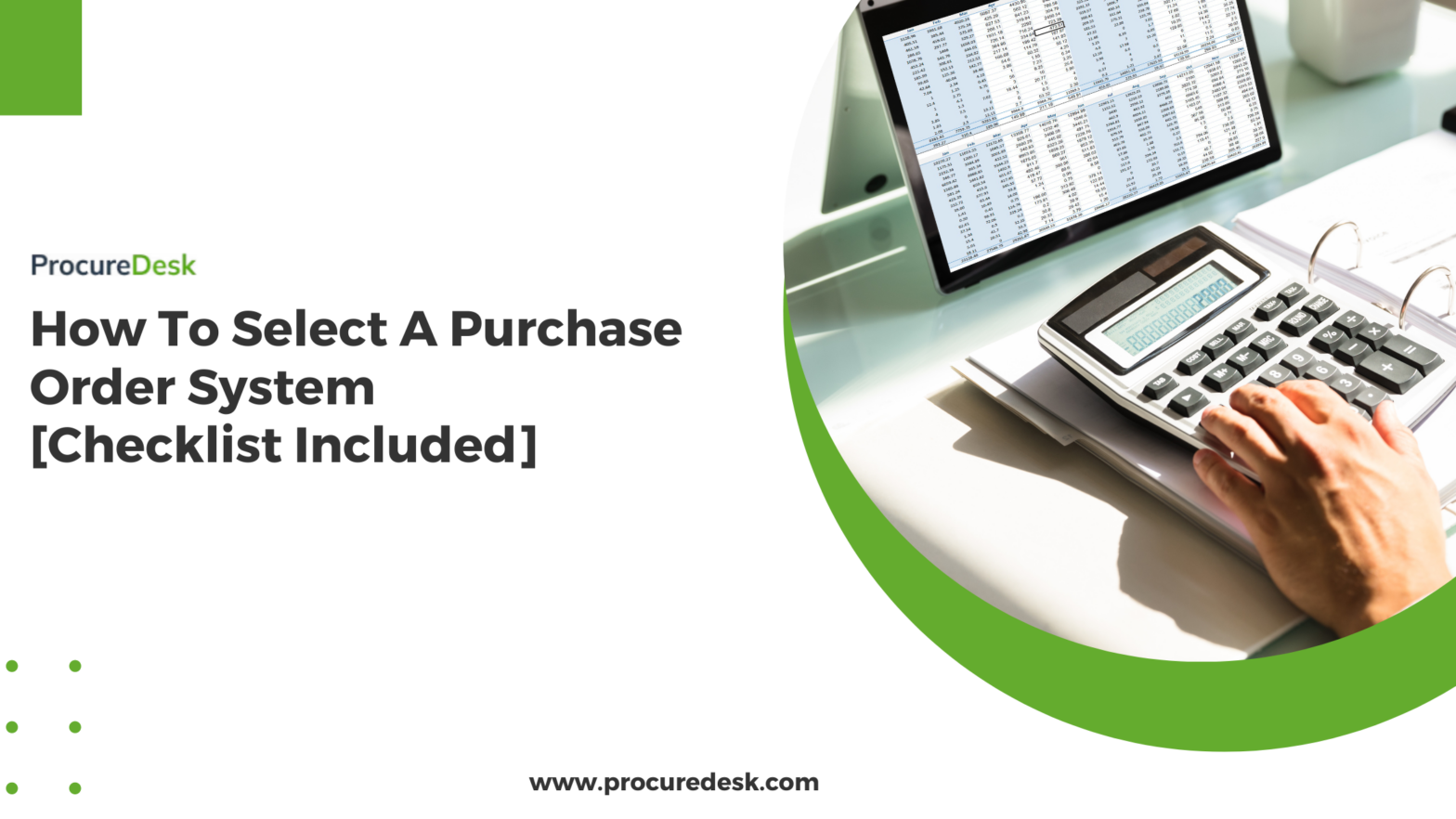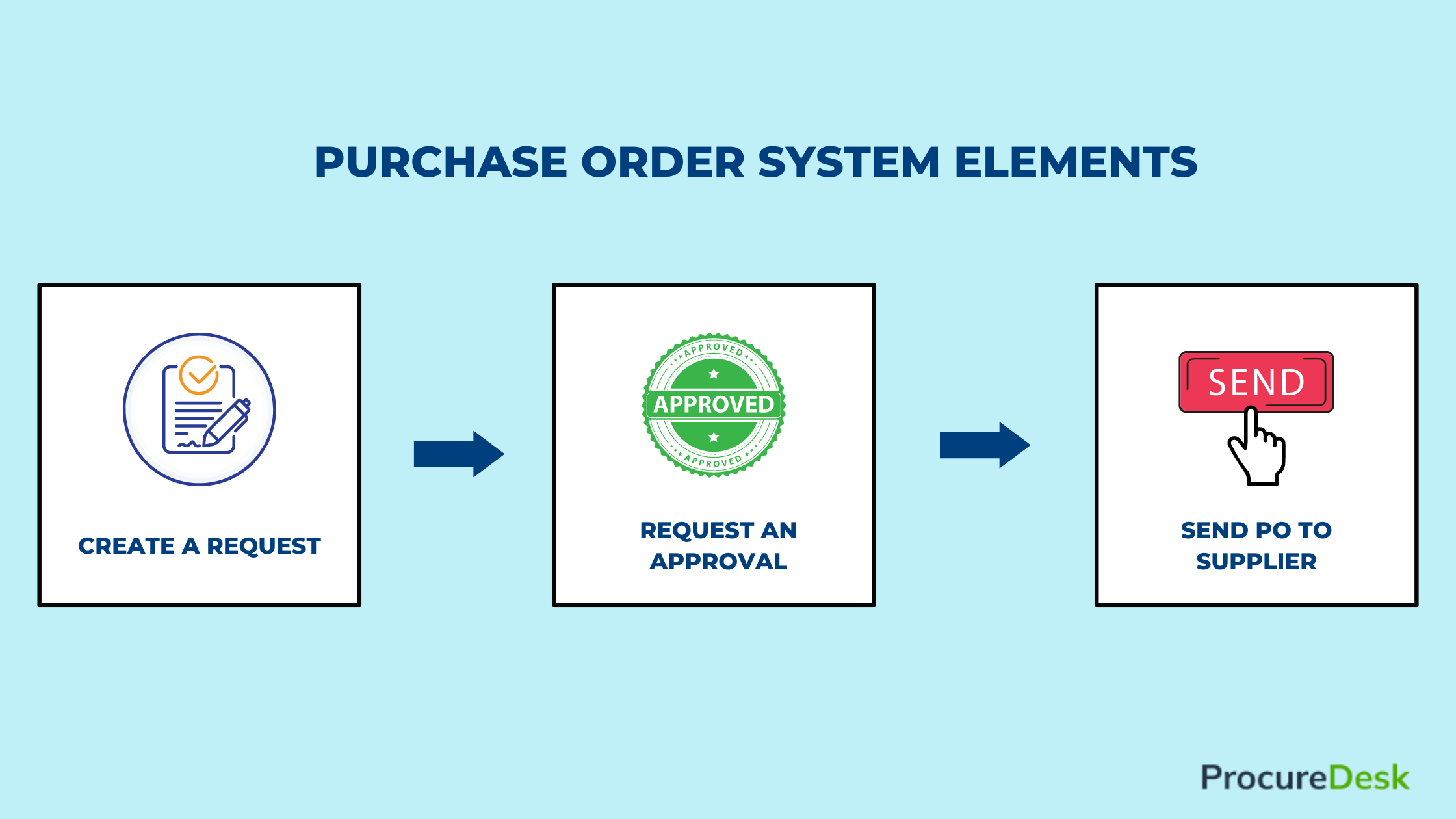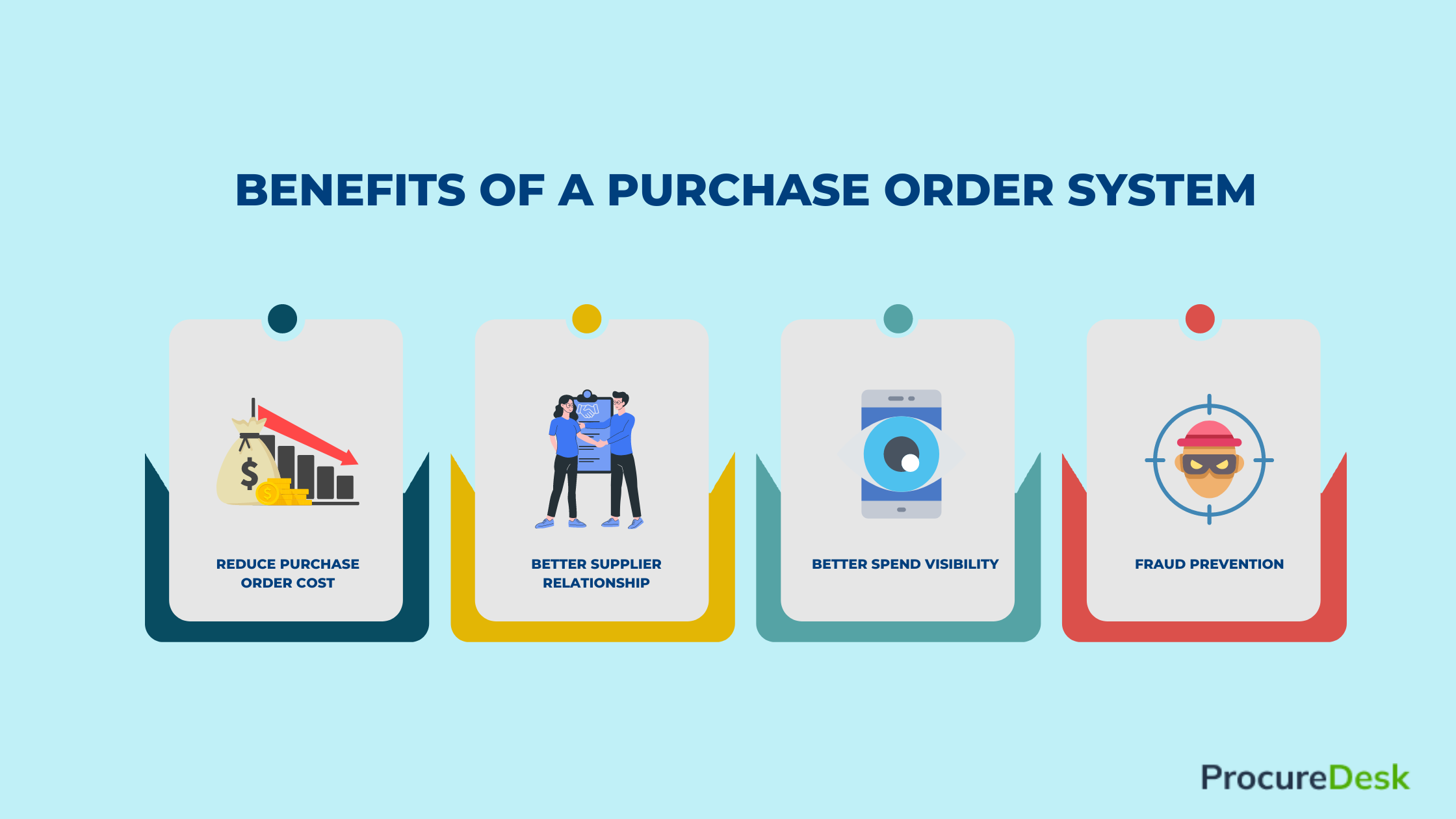Bonus: Purchase Order System Checklist
Are you a small or medium-sized business issuing more than 10-20 purchase orders in a month? If so, a purchase order system is exactly what you need.
Based on our experience, we have seen many of our clients follow this exact strategy to streamline their manual purchasing process. In this blog, we’re going to cover how to select a purchase order system for your business to help you achieve the following:
- Reduce 45% on time spent creating purchase orders
- Reduce stockouts by 20% with orders arriving on time
- Eliminate spreadsheets for purchase order tracking
What Is A Purchase Order?
Let’s define what a purchase order is and the different components of the purchase order system.
If you are familiar with what is a purchase order, please feel free to skip this section.
The official Wikipedia definition of a purchase order is as follows
“A purchase order (PO) is a commercial document and first official offer issued by a buyer to a seller, indicating types, quantities, and agreed prices for products or services. It is used to control the purchasing of products and services from external suppliers.”
Like any other legal contract, PO has an offer and acceptance cycle.
A buyer sending the purchase order is just an offer to purchase from the supplier. The PO becomes legally binding when the vendor accepts the offer by acknowledging the purchase order. The vendor can accept the order as-is or ask for a change order. Having a purchase order simplifies this back and forth between buyer and supplier.
A sample purchase order is below:
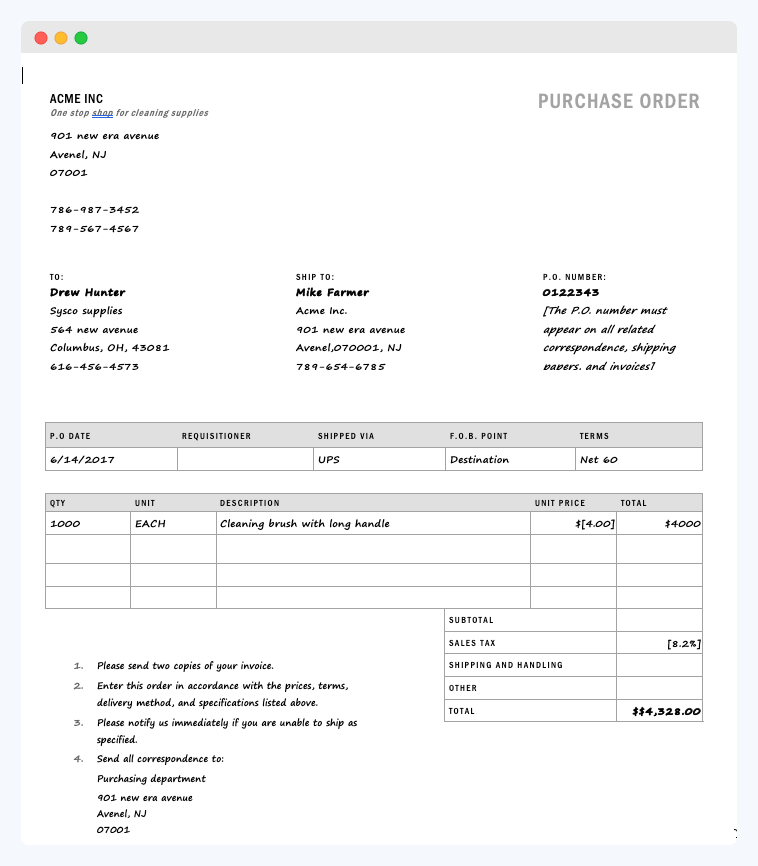
Download free PO template in Microsoft Word
A purchase order has the following components:
a) Purchase Order Header
A purchase order header consists of the following components:
- Buyer details: This covers the basic information like company name, address, logo, etc.
- Shipping information: This section covers the order location for the supplier, where the order should be shipped to, and the Purchase order number.
- Currency: The header of the purchase order lists the currency for the purchase.
- Vendor details: This section covers the vendor address, vendor contact information, and so on.
- Billing address: By adding a billing address, you can ensure that the suppliers send the invoice to the right person
b) Key Terms
This section lists key terms, including shipping method, trading terms, and agreed or standard payment terms for your suppliers or any additional terms.
c) Purchase Order Line Items
Order Line item details: this section contains line items that you are purchasing from the vendor. The key fields are the description of the item purchases, quantity, unit of measurement, unit price, and total. You might have additional fields to track whether it is an inventory or noninventory item.
d) Taxes And Other Information
This section lists the taxes related to the purchase and other charges like Freight etc.
Should I Use Purchase Orders?
Whether you should use purchase orders or not can be assessed by the following two factors.
Purchasing Mix
If you have a low purchase volume or most of the purchases are non-repeatable, you probably won’t get the most value out of a purchase order process.
For example, if you purchase supplies from Walmart and Sam’s, you don’t need a purchase order process because the vendors don’t accept a purchase order.
You can still think about setting up an approval flow to control your cost, but a purchase order process would not have much value.
The Complexity Of The Purchasing Process
If you have a simple purchase process – then you don’t need to use purchase orders.
For example: if you are a ten-person company, one person is responsible for ordering all products and services, and everything is paid by cards, you don’t need a purchase order process.
If you don’t have a need for inventory stock management, then you probably don’t need a purchase order system.
What Is A Purchase Order System?
A purchase order system is software that helps you create, issue, and track purchase orders. A purchase order system is an effective Spend management tool.
If you are not familiar with purchase orders, see the definition below.
At a very high level, it is a purchase order process system that allows you to do the following:
Create A Purchase Order Request
When an employee needs to purchase a product or service, they need to issue a purchase order to the vendor. This is not true for small purchases, but a purchase order is typically required for all major purchases.
Approval Of A Purchase Order
Before you send the PO to the supplier, it needs to be approved by the management or finance team. This is to ensure that the purchase is authorized and you have a budget set for this purchase.
Send Purchase Order To The Vendor
The final step is to send the purchase order to the supplier. Companies spend a lot of time on this step because they don’t have an easy way to generate a purchase order.
These three steps could cost companies anywhere from $60 – $500/ purchase order. That is the cost of the purchase order.
This is a huge range, and we recommend that you calculate your purchase order cost to get an accurate estimate of the cost of the purchase order process.
What Features Should You Look For In A Purchase Order System?
One key step to looking for a purchase order system that fits your business is by knowing the important features you should keep an eye on.
For the purpose of this blog, we’re going to use our tool ProcureDesk as an example.
Let’s review the key features of a purchase order system and how it helps streamline your purchasing process.
Purchase Request
A requisition process allows employees to create a purchase requisition to have the spend authorized before the purchase.
Employees can create a requisition from a catalog (Internal or external), or employees can enter the data into the system.
How it helps:
- A requisition process provides a mechanism for employees to purchase products or services they need for running the business.
- It eliminates the need for manual purchase requisitions and back-and-forth emails.
- It helps you with cost control because all purchases are pre-approved, and the management has the opportunity to review and approve or reject the purchase.
Here is an example of how a purchase requisition works in ProcureDesk:
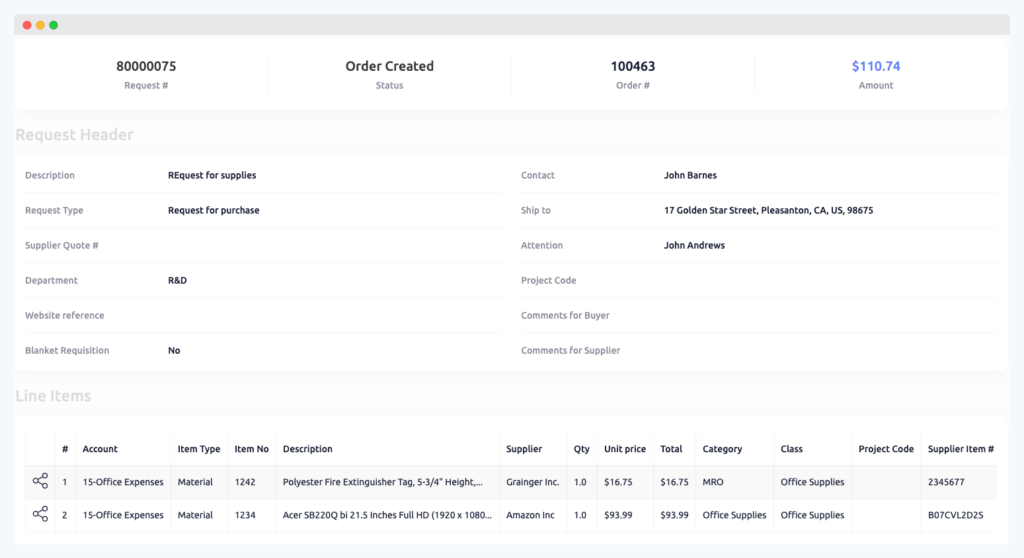
Purchase Order Workflow And Approvals
The ability to route purchase approvals to different stakeholders so that the spending can be authorized.
With flexible workflows, you can easily route the request to department budget owners. That way, they have complete visibility into what is being purchased.
How it helps:
A flexible approvals process helps with the following:
- No more emails for approvals as approvals are managed in one system.
- With the help of flexible purchase approvals, you can route the request to different stakeholders. For example, a spend over $100,000 needs to be approved by the CEO or CFO.
- You can set up different approvals for Opex and Capex budgets.
- With a mobile app, you can approve the requisitions on the go to speed up the approvals and reduce the purchase order process.
- Automated email notifications ensure that their request for approval is not lost.
Here is an example of how a flexible workflow might look like in ProcureDesk:
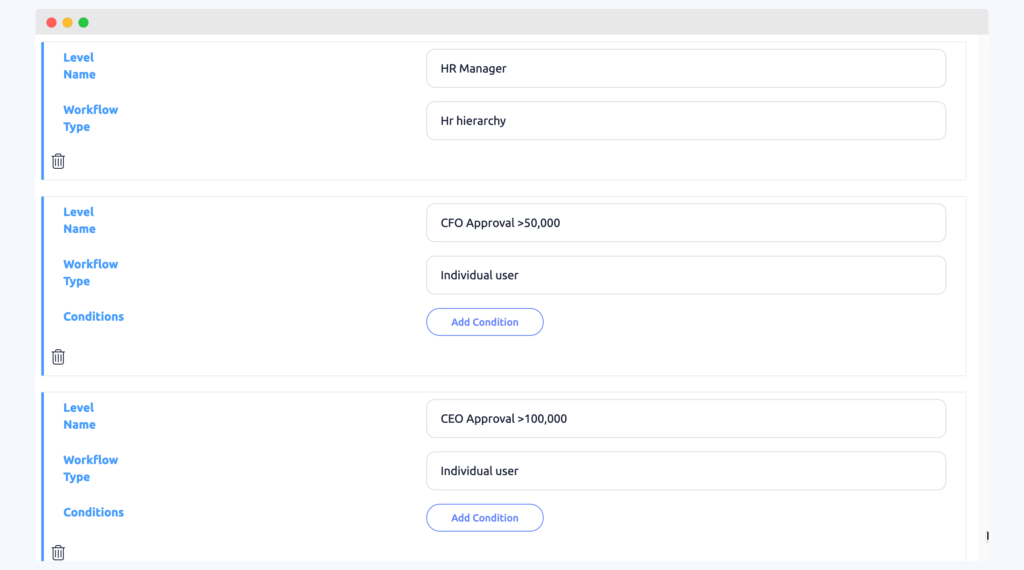
Budget Tracking
A Budget feature allows you to set up budgets for cost control. The finance team can set up the budgets at a department level, a project level, or any other structure.
With Budgets, you can not only control costs but provide budget visibility to the stakeholders.
How it helps:
- With Budgets, you can see real-time consumption. So no more surprises at month-end regarding exceeding set budgets.
- Your stakeholders can approve the purchase requisitions with confidence because they always have complete visibility into the available budget.
- It helps you build a cost-conscious culture because everyone knows the allocated budget and the remaining amount.
Here is an example of how the Finance team can set up budgets for cost control:
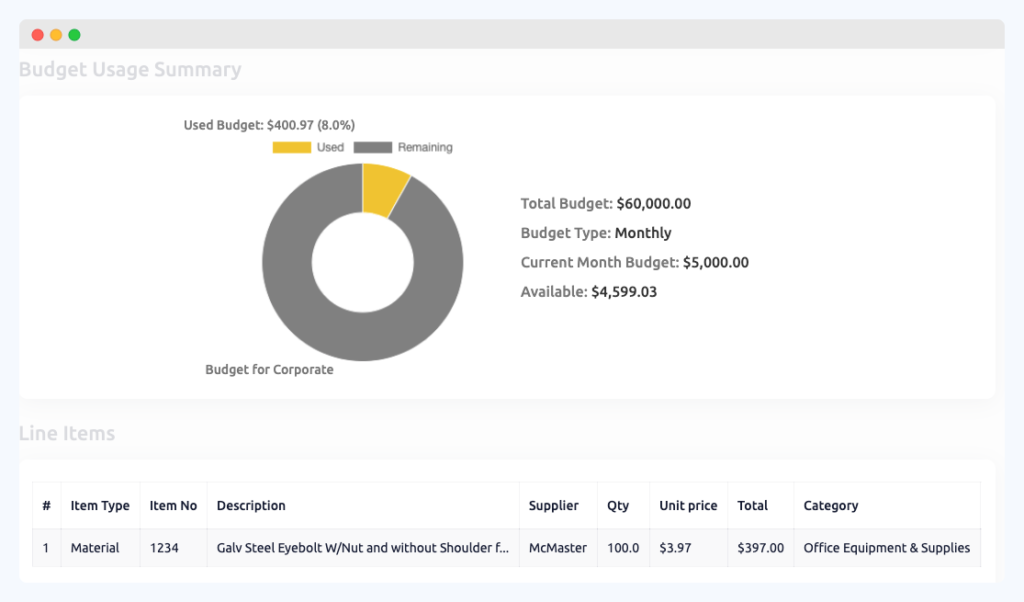
Catalogs
Catalogs help with improving the purchasing experience of the employees.
Catalogs provide an online purchase experience for the employees.
Instead of remembering what information to type, they can simply browse or search the catalogs and find the right product or service.
How it helps:
- With catalogs, you can significantly reduce the time spent on creating purchase requisitions.
- It helps you save costs because you can route the employees to your preferred vendors.
- It helps you consolidate vendors because, with catalogs, employees already know who your top vendors are. So they don’t create additional vendors for similar products or services
Here is how a catalog can simplify purchasing for you using ProcureDesk:
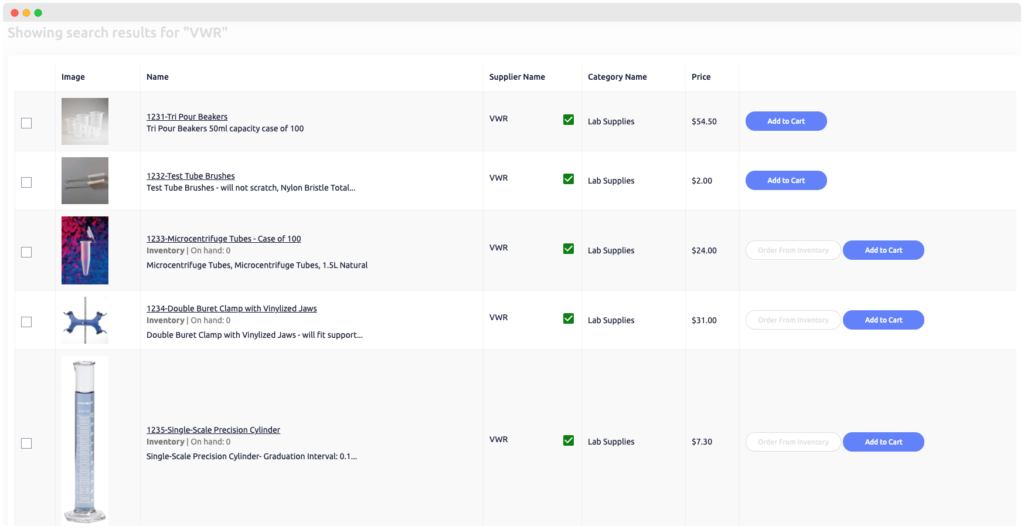
Purchase Order
The purchase order functionality allows you to create purchase orders and send the purchase orders to different vendors.
A purchase order is a legal document that is an offer from the buyer to the supplier. Once the supplier acknowledges the order, the purchase order becomes legally binding.
How it helps:
- The purchase order feature eliminates the need for manual purchase orders. No more manual PO creation!
- It provides you with a central place to track all your purchase orders. Instead of keeping purchase orders in your computer folders, you can track them in a system.
- With a purchase order process, you can better control your cash flow because now you instantly see committed Spending.
Here is an example of a system-generated purchase order in ProcureDesk:
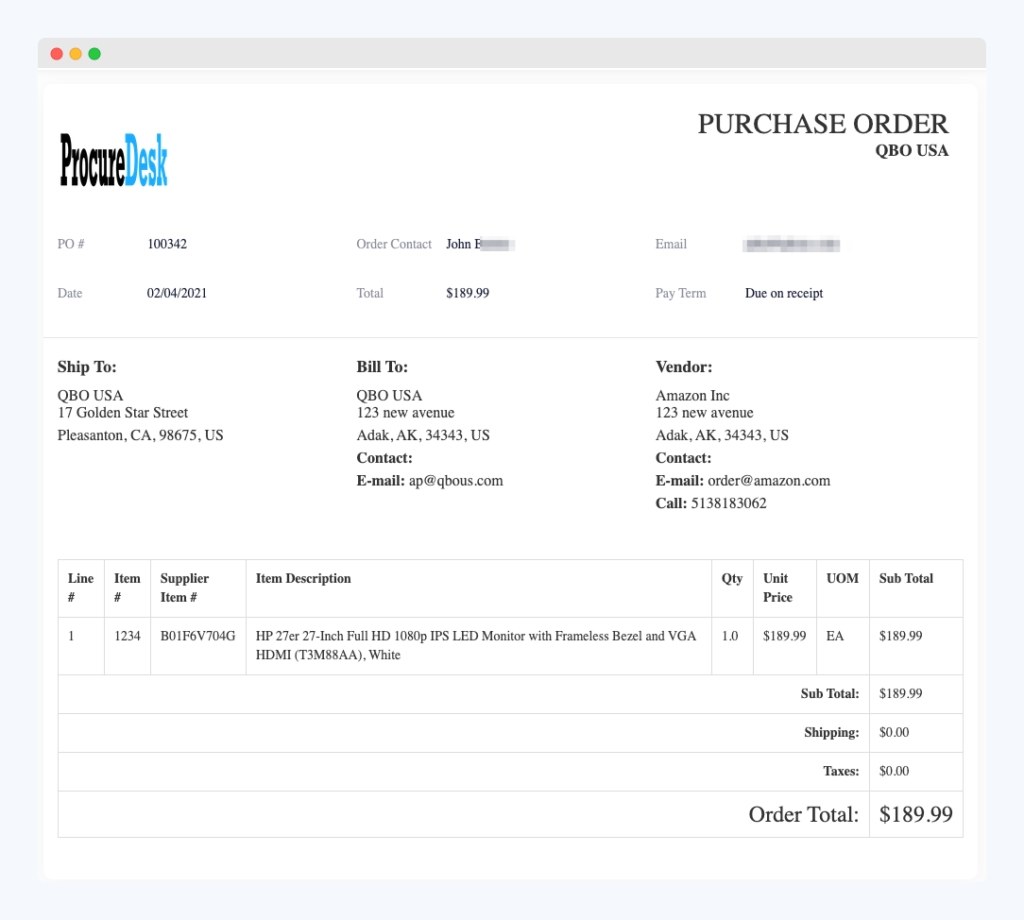
Purchase Order Tracking
Purchase order tracking functionality allows you to track the status of the purchase order through its life cycle.
A purchase order tracking functionality allows you to answer the following questions:
- Does the vendor acknowledge the order?
- Has the product shipped, and where is it in transit?
- Is the product delivered to the end-user?
How it helps:
- The most significant benefit of purchase order tracking is that you always have the latest information about purchase orders in one place.
- No more spreadsheets for tracking vendor purchase orders.
- No more worries about orders not being delivered because you can see whether the order is shipped or not.
Here is an example of a central purchase order tracker in ProcureDesk:
![]()
User-Friendly Interface
Though it is not a feature, a user-friendly purchase order system would help drive adoption and increase purchasing compliance.
So along with other features, you should also evaluate the ease of use. This can be done through a quick demo or a quick trial.
Integration With The Accounting System
An integrated system allows you to automatically sync the purchase order and invoice date with your accounting system.
Let’s say you use QuickBooks Online or Enterprise as your accounting system.
After creating purchase orders and Invoices in your cloud-based system, you need to sync that data with the accounting system to book the cost to the correct chart of accounts.
Without an integration interface with the accounting system, you have to enter the data in your accounting system manually.
How it helps:
- No more manual data entry into your accounting system. That not only saves time but also eliminates any data entry errors.
- With a purchase order system, the purchase orders are automatically created and synced with your accounting system. So there is no need to have a dedicated resource for data entry into your accounting system.
Granular Access Control
As your company grows, you need better access controls. This allows you to control individual users or user group access.
For example, You only want certain users to see all purchase orders in the company.
Or do you only want certain users to change the purchase order after an order is created?
How it helps:
- With granular access controls, you can meet the segregation of duties and other compliance requirements like SOX (Sarbanes Oxley).
- You can control the information flow and decide who can do what in the system.
- You don’t have to open up your purchasing system to all users. For example, you can control that only a few employees can issue purchase orders and commit the spend to the supplier.
Here is an example of what the granular access control looks like in ProcureDesk:
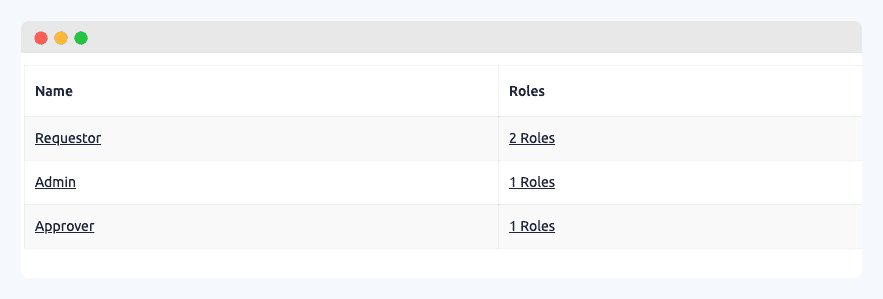
What Are The Benefits Of A Purchase Order System?
Here are the top benefits of a cloud-based purchase order system:
Reduce The Average Cost To Process A Purchase Order
When it comes to the cost of processing a purchase order, there is no simple answer.
For example, the manufacturing industry has an average cost of $59, and the petroleum industry has an average cost of $741 (As per CAPS(Center for Advanced Procurement Strategy) research).
Such a broad range is due to the process complexity and the number of people involved in reviewing the purchase order before it is sent to the supplier.
The cost to process a PO = Total yearly cost/number of purchase orders issued.
So even if you have a single employee with an average annual loaded cost of $75,000 and the total PO processed is 60 a month or 720 a year. Then the average cost per PO is $104.
By implementing an automated purchase order system, you can eliminate the cost of processing the PO by 40-50%.
Better Relationship With Your Supplier
A side benefit of automating the purchasing process is an improved relationship with suppliers. Automated purchasing process leads to
- Reduced errors in the purchase orders; hence suppliers spend less time correcting errors and processing the purchase orders.
- It provides better visibility to the supplier. Since the process is automated, suppliers know how much time it takes to process orders.
- It avoids any duplicate purchase orders so that you are not spending time creating returns for products you don’t need.
Visibility Into Spend At A Granular Level
If you have a manual purchase order process, chances are you have limited visibility into company Spending.
Most of the companies rely on reports like Spend by the Supplier or spend by GL accounts. Beyond that, you must dig up the PO documents to find additional information.
With an automated purchase order system, you can get granular visibility at the line item level, which helps you better plan your budgets, and understand cost trends. The granular visibility provides better spend data which you can use for negotiations with your suppliers. It is not uncommon for companies to find out that they pay different rates for the same product across different departments.
Fraud Prevention
You can ensure that the orders are authorized as per your purchasing policy by implementing automated approval workflows.
Most purchase order systems maintain an audit trail, and you can review the purchase approval history at any time.
With automation, you can build approval workflows so that employees don’t need to evaluate who should be approving the purchase. The purchase system automatically does that for you and helps in preventing procurement fraud.
Legality
Though it is ideal to have negotiated contracts for all the purchases, that is not always the case. In those cases, purchase order terms are a good substitute.
Every purchase order should list the standard buyer terms for the purchase, and that provides the general agreement on how both parties will conduct business.
Purchase orders include commercial terms like payment terms, product warranties, etc. It also includes legal terms like the limitation of liability, indemnification, etc.
If there is a dispute, these terms can help resolve it rather than leaving it open-ended.
If a case ever goes to a court of law, the standard terms can provide the general agreement framework rather than standard commercial terms.
Invoicing Efficiency
With the purchase order system, you can gain efficiencies in purchase approvals and productivity improvements and ultimately reduce the time spent processing purchase orders.
However, that is just one side of the equation.
Once the vendor delivers the order, the vendor sends an invoice for the products they have provided or the services rendered.
If you stop with a purchase order process, you leave a lot of efficiencies on the table.
Customers who have implemented an AP automation solution along with a purchase order system see the following benefits.
Matching Purchase Order And Invoice
Once you have the purchase order number, you can automatically match the supplier invoice with the purchase order.
With an integrated purchasing and invoicing system, the Accounting team doesn’t have to spend time matching the purchase orders with the invoices.
The system can automatically match the purchase order and invoices, mark the invoices for payment, or route the invoice for exception approval.
Approval workflow / Exception routing engine
The automated matching process might result in one of the two scenarios:
Perfect match:
A perfect match is when the invoice document matches the quantity and price on the invoice, and there is a receipt for that order.
Exception:
That is an exception scenario when an invoice doesn’t match the purchase order or the receipt.
For example, the unit price on the order is $10, and the vendor invoiced you for $13 per unit.
An integrated purchasing and invoicing system can automatically route the document for approval to the concerned parties if there is an issue.
That saves a lot of time because AP is now not investing endless hours chasing down stakeholders.
7 Steps To Create A Purchase Order System For Your Business
Creating a purchase order (PO) system for your business can streamline the procurement process and ensure efficient management of purchases. Here are seven steps to help you establish a purchase order system:
- Define Your Requirements: Identify the specific needs and requirements of your business. Consider factors such as the types of goods or services you regularly purchase, budget constraints, approvals, and any legal or regulatory requirements.
- Select a Purchase Order Software or System: Choose a purchase order software or system that suits your business needs. Look for features such as user-friendly interface, customizable fields, integration with accounting software, reporting capabilities, and scalability.
- Set Up Purchase Order Templates: Design purchase order templates that include essential information such as vendor details, item descriptions, quantities, prices, terms, delivery dates, and any special instructions or terms and conditions. Ensure consistency across all purchase orders.
- Establish Approval Workflows: Define approval workflows to ensure proper authorization of purchase orders. Determine who needs to approve purchase requests based on factors such as the dollar amount, department, or project. Automate the approvals wherever possible to expedite approvals and reduce delays.
- Integrate with Accounting Systems: Integrate your purchase order system with your accounting software to streamline the procurement-to-pay process. This integration facilitates seamless recording of purchase transactions, tracking of expenses, and generation of financial reports.
- Train Employees: Provide training to employees involved in the purchase order process. Ensure they understand how to use the purchase order system effectively, including how to create purchase orders, submit requests, track orders, and adhere to company policies and procedures.
- Monitor and Evaluate Performance: Regularly monitor the performance of your purchase order system to identify areas for improvement. Track key metrics such as order cycle time, approval turnaround time, accuracy of orders, vendor performance, and compliance with procurement policies. Use feedback from users and stakeholders to make adjustments and enhancements as needed.
By following these steps, you can establish a robust purchase order system that improves efficiency, accuracy, and control over the procurement process, ultimately contributing to the overall success of your business.
What Is The Purpose Of A Purchase Order System?
Why do you need a purchase order system, or what is the purpose of the purchase order system?
If you are asking yourself this question, here are a couple of points to consider:
Automating Your Purchase Order Process
The apparent purpose of a purchase order system is to systemize your purchasing process.
But every automation project is also an opportunity to improve the process and make it more straightforward.
When you are looking at automating a purchasing process, see how you can improve upon the process and make it better.
Here are some things that you can improve upon:
- Simplify the purchasing authorization matrix: For example, not every purchase requisition needs to be approved by the CFO of the company. You can read more about setting purchase order approvals here.
- Set up catalogs for a better employee experience: If you are purchasing similar items, again and again, you can set up a catalog so that employees can create orders with one click. Vendor catalogs improve purchasing experience for your employees.
A single place to track all purchase orders
With a purchase order system, you get a central place to track all purchase orders.
If you have been using spreadsheets for order tracking, then you know how painful that process could be.
It is hard to keep Spreadsheets updated because the information keeps on changing. For example, change orders and change in delivery dates, etc.
And if you have multiple people approving the purchase orders, that could be a nightmare to ensure that the changes are not getting updated.
Here a central dashboard looks like in a purchase order system:
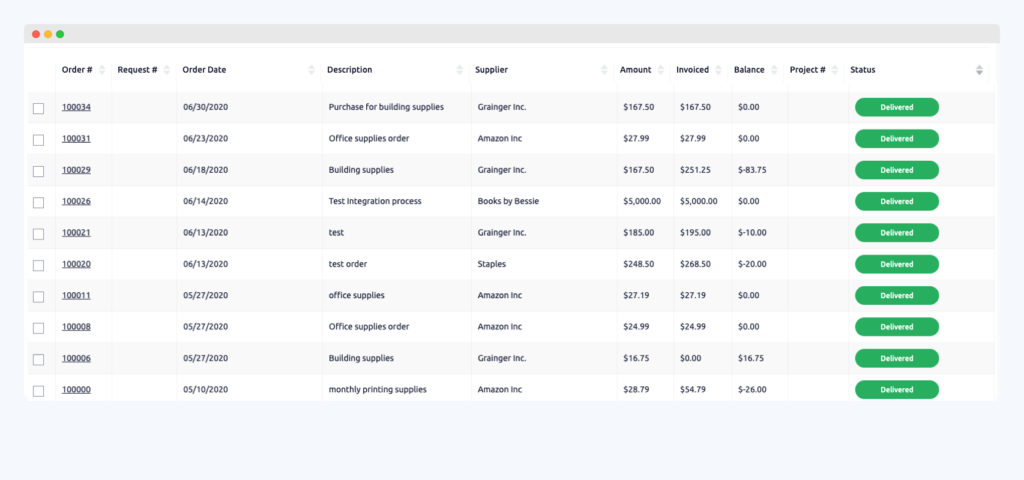
Better Cost Control
With a purchase order system, you get better cost control.
With a purchase authorization process, the individual team or manager can control spending by evaluating the purchase request.
You can use this process for cost avoidance( not purchasing at all) or deferring the cost to better meet your cash flow goals.
Here is how simple it becomes to control cost with a PO approval:
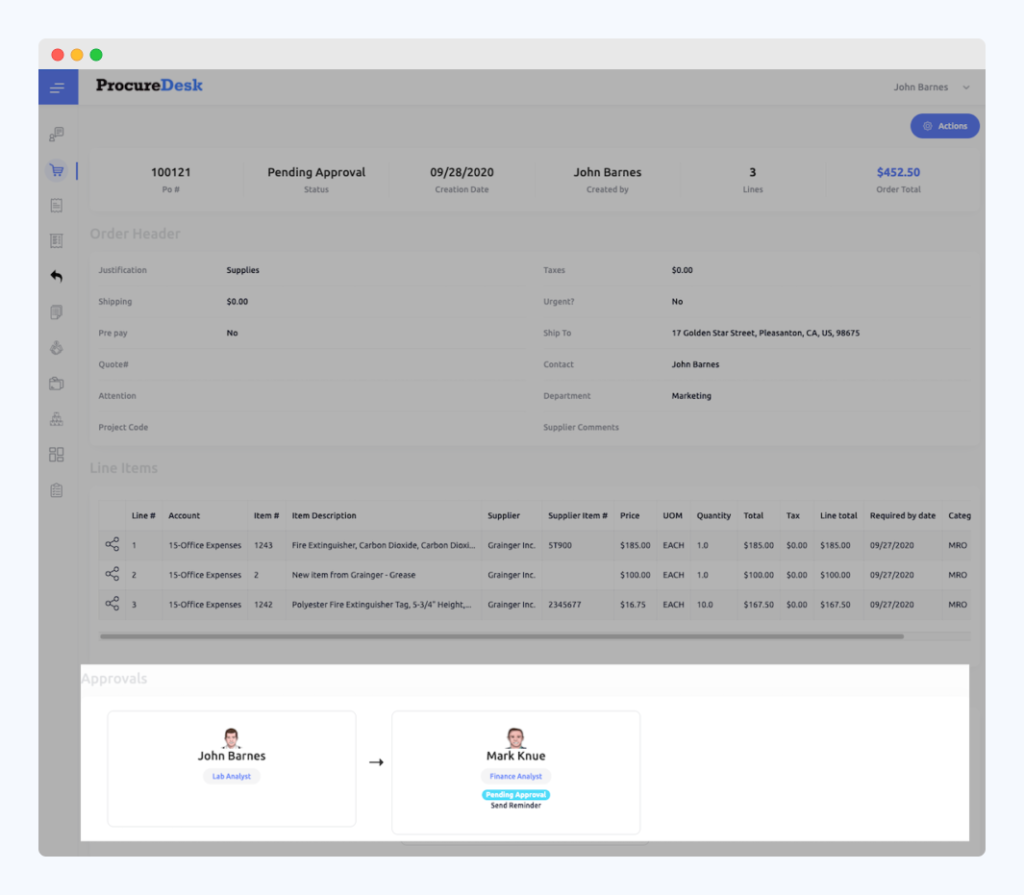
Bonus: Purchase Order System Checklist
FAQs
What Is The Main Purpose Of A Purchase Order?
The main purpose of a purchase order (PO) is to formalize and document the intent to purchase goods or services from a supplier.
It serves as a legally binding contract between the buyer and the supplier, outlining the specific details of the transaction, including item descriptions, quantities, prices, delivery dates, terms, and conditions.
Purchase Order vs. Invoice
While both purchase orders and invoices are essential documents in the procurement process, they serve different purposes and stages of the transaction:
- Purchase Order (PO): A purchase order is issued by the buyer to initiate a purchase from a supplier. It outlines the details of the order, including item descriptions, quantities, prices, delivery dates, and terms.
- Invoice: An invoice is a request for payment issued by the supplier to the buyer after goods or services have been delivered. It serves as a billing statement, detailing the products or services provided, their respective prices, any applicable taxes or fees, and the total amount due.
How Does A Supplier Use The Purchase Order?
A supplier uses a purchase order (PO) as a formal request from a buyer to supply goods or services.
Upon receiving a purchase order, the supplier verifies the details, including item descriptions, quantities, prices, delivery dates, and any special instructions.
The supplier then acknowledges the PO, indicating acceptance of the terms and conditions outlined.
Once the goods or services are delivered, the supplier generates an invoice based on the information provided in the purchase order, which serves as a request for payment from the buyer.
What Are Purchase Order Types?
There are several types of PO’s commonly used in business transactions:
- Standard Purchase Order: This is the most common type of purchase order, used for regular procurement of goods or services at agreed-upon prices and terms.
- Blanket Purchase Order: A blanket PO is used for recurring purchases of goods or services over a specified period, typically with a set limit on the total value of orders.
- Contract Purchase Order: This type of PO is based on a formal contract or agreement between the buyer and supplier, outlining specific terms, pricing, and conditions for future purchases.
- Single Purchase Order: A single PO is issued for a one-time purchase of goods or services, often for ad-hoc or non-recurring procurement needs.
Why Can’t You Create POs Manually?
Manual processes increase the risk of data entry mistakes, discrepancies, and delays in order processing.
Additionally, manual PO creation lacks centralized tracking and visibility, making it challenging to monitor orders, manage approvals, and track spending effectively.
Do Online Stores Need PO Systems?
Yes, online stores can benefit from implementing purchase order (PO) systems, especially as they grow and scale their operations.
While online retail transactions often involve immediate payment at the point of purchase, businesses still need to manage procurement activities for sourcing inventory, supplies, or services.
A purchase order system enables online stores to streamline the purchasing process, track orders from suppliers, manage inventory levels and maintain accurate financial records.
Who Creates A Purchase Order?
Considering that you have evaluated your situation and decided that a purchase order process makes sense. The obvious question is, who should create purchase orders?
There are two options:
- Employees create purchase order requests: In this case, an employee can create a purchase order request, and send it for approval. After it is approved, the purchase order system should automatically dispatch the purchase order to the vendor. A vendor might require a purchase order to be emailed or sent via EDI or other electronic methods. A good purchasing system should be able to support these different methods.
- Buyers/Procurement team creates orders: This scenario is recommended when the purchasing team reviews the purchase requisition request before the order is sent to the vendor. In this case, the employees can create a purchase requisition This process gives you more flexibility on what can or can’t be ordered. This also lets the procurement team review the orders, seek vendor quotes, and get better pricing if possible.
The Bottomline
Implementing a purchase order system in your business can lead to significant time savings and efficiency gains.
By streamlining the procurement process, automating approval workflows, and integrating with accounting systems, you can reduce the time spent on purchase orders by at least 30%.
This not only frees up valuable resources but also enhances accuracy, transparency, and control over purchasing activities.
Investing in a purchase order system is a strategic decision that can yield tangible benefits, driving productivity and contributing to the overall success of your business in the long run.



